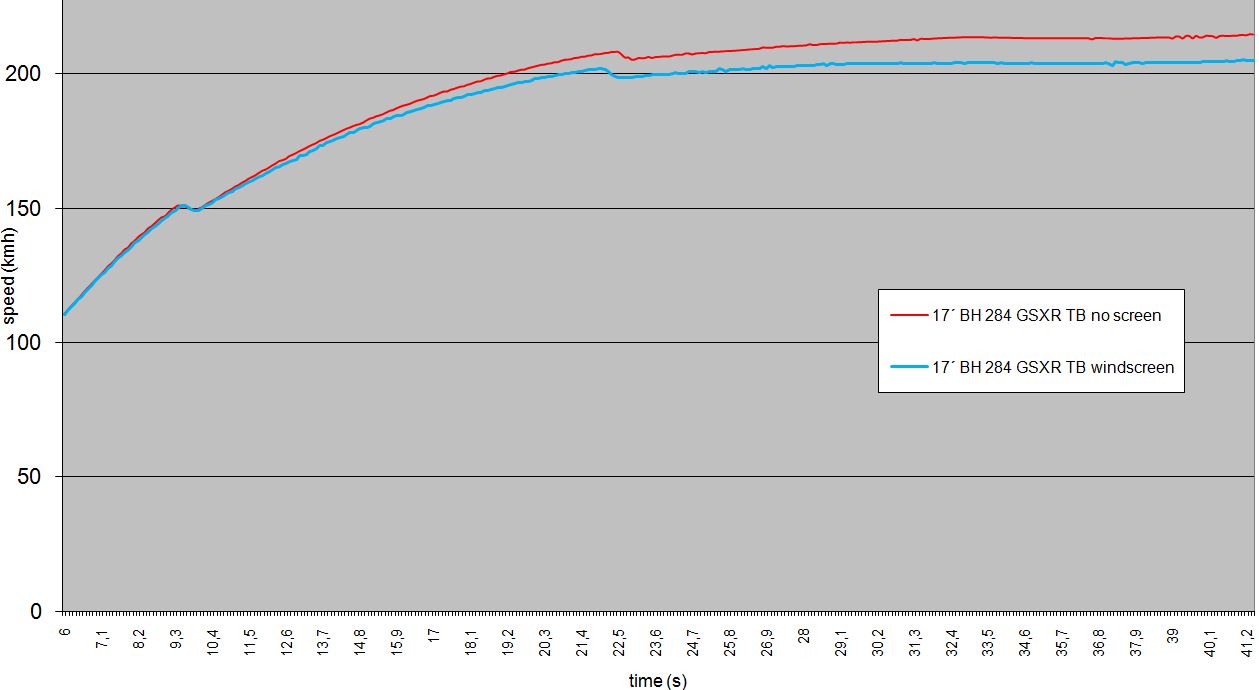black.viper
|
| posted on 16/5/17 at 10:39 AM |

|
|
Compare speed with and without windscreen
Hi,
I compare speed with and without windscreen. Measure is made by 10Hz Datalogger Quartz818XT.
kitcar - Tiger Cate E1, Duratec engine (GSXR TB, Camshaft 284°), 205/60 R13 Falken tyres, sierra lsd diff 3,92, gearbox T9 std

and here is graph:

I hope it will help someone in making decisions :-) especially on trackdays ...
max speed with windscreen was 205 kmh (127 mph)
max speed without windscreen was 216 kmh (134 mph)
Im building Tiger Cat E1 Duratec engine
|
|
|
|
|
ElmrPhD
|
| posted on 16/5/17 at 11:01 AM |

|
|
Cool. Thanks!
Always nice to get some empirical data!
|
|
|
loggyboy
|
| posted on 16/5/17 at 12:25 PM |

|
|
How many runs did you compare?
Did you check in different directions to compare to with/against wind.
Mistral Motorsport
|
|
|
black.viper
|
| posted on 16/5/17 at 12:39 PM |

|
|
quote:
Originally posted by loggyboy
How many runs did you compare?
Did you check in different directions to compare to with/against wind.
:-) I needed measure difference only
It was a same time and day - now wind, one direction only, flat terrain, one run only with each spec
I was interested in what is real difference between noscreen and with
Im building Tiger Cat E1 Duratec engine
|
|
|
SteveWallace
|
| posted on 16/5/17 at 01:48 PM |

|
|
Nice data.
I've often wondered about that as I've been thinking about getting a windscreen for my Viento to make it more drivable under day to day
conditions, as it would be nice not to have to wear a helmet all the time. For all practical purposes then, unless you are pushing hard on a track,
it makes next to no difference
"I know every nut and bolt and cog in that car, I built it myself" - The Prisoner, 1967
|
|
|
Benzine
|
| posted on 16/5/17 at 02:08 PM |

|
|
Good idea. Data set is tiny though, would be good to see a lot more runs
|
|
|
SteveWallace
|
| posted on 16/5/17 at 02:27 PM |

|
|
It might be a small data set and a good scientist should always repeat their experiment, but the results are very much as you might predict and he
should be commended for doing it. The windscreen increases drag, but this isn't very noticeable until you get to high speeds as drag force is a
function of the speed squared. The curves look as you might expect except that the x-axis is off a little (or he can accelerate from 0-110 kmh in
zero seconds  ) )
"I know every nut and bolt and cog in that car, I built it myself" - The Prisoner, 1967
|
|
|
SteveRST
|
| posted on 16/5/17 at 02:59 PM |

|
|
Yep, interesting data even if limited scope. Thanks for sharing.
So basically you're not seeing the increased drag make any noticeable different until speed of 160 km/h (100mph) or more.
|
|
|
loggyboy
|
| posted on 16/5/17 at 04:08 PM |

|
|
I recall doing quite a few test when we first past our tests in my mates, the difference between windows up and down on tintops (850cc mini and mk1
fiesta 1.1) and both showed a distinct 10mph difference.
Mistral Motorsport
|
|
|
black.viper
|
| posted on 17/5/17 at 08:28 AM |

|
|
quote:
Originally posted by SteveWallace
It might be a small data set and a good scientist should always repeat their experiment, but the results are very much as you might predict and he
should be commended for doing it. The windscreen increases drag, but this isn't very noticeable until you get to high speeds as drag force is a
function of the speed squared. The curves look as you might expect except that the x-axis is off a little (or he can accelerate from 0-110 kmh in
zero seconds  ) )
Sorry, now I change x axis for right timing :-) and cut graph for better display.
Im building Tiger Cat E1 Duratec engine
|
|
|













